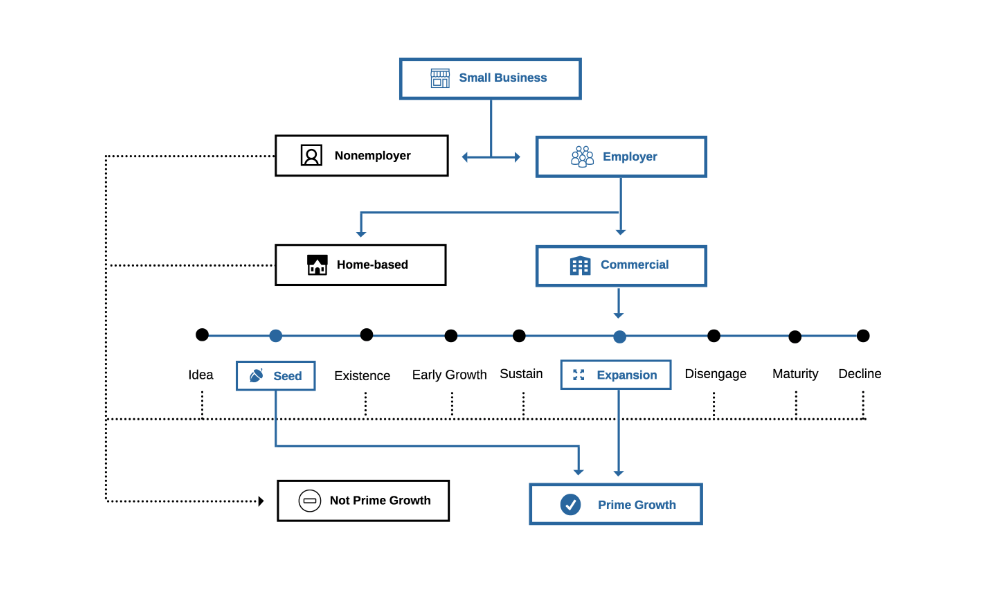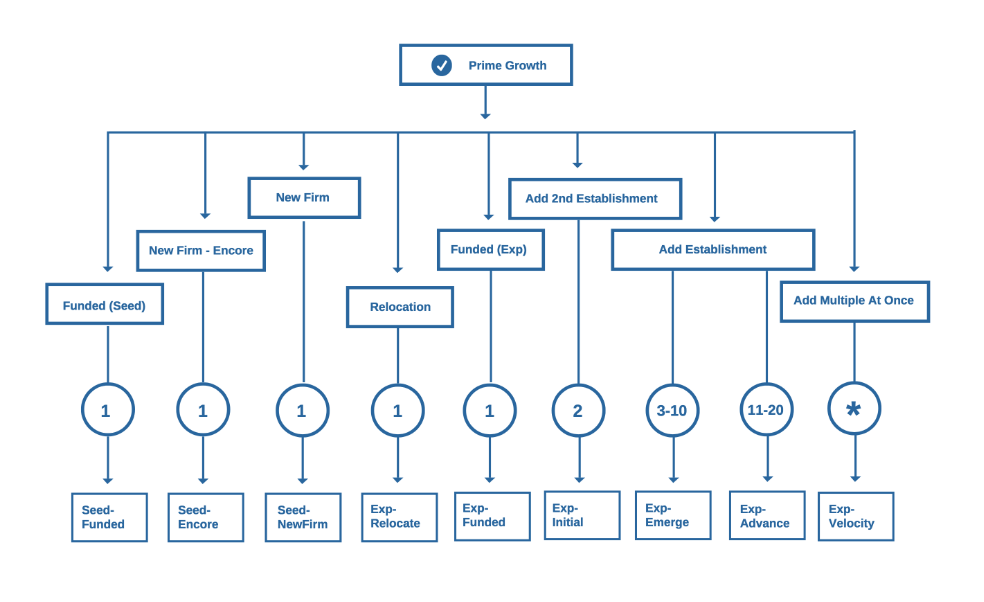Small Business Ecosystem Dynamics
The Prime Growth Classification Standard
By Steve Waters
Founder & CEO, SMB Intelligence
Growth-based classification uses development stage, growth format and growth scale to categorize firms, rather than traditional small business segmentation (industry, revenues, company age, company size, and digital engagement).
The purpose of the standard is to identify prime growth firms and group them into nine segments based on their current growth priorities.
What are prime growth firms?
We define an independent as a single establishment (location) firm with less than 500 employees, and a small chain as a firm with more than 1 and up to 20 establishments. It is important to note that while we include firms with up to 500 employees, nearly all (98%) of small businesses have less than 100 employees, and 96% have less than 50.
An employer is defined as a firm that has employees other than the founder. A commercial location is defined as a place of business that is not a residence.
Seed stage is defined as a new firm that is pre-revenue, pre-opening, currently planning their launch. Expansion stage is defined as an existing small business currently planning to add an establishment, relocate their firm or an establishment, or that has just raised substantial outside funding.

What are prime growth
segments?
Growth format defines the manner in which the planned growth is to take place: launching a new firm, adding an establishment, relocating the firm or an establishment, or allocating recently raised funds to support substantial growth.
Growth scale defines the total number of establishments a firm has, including planned expansion establishments.
Based on their combination of growth scale, growth format and current development stage, they are assigned to one of nine segments. This segmentation groups prime growth firms by their current growth priorities.
Seed – New Firm
New, seed stage, pre-revenue, pre-opening firms currently planning to launch their firm.
Seed – Encore
New, seed stage, pre-revenue, pre-opening firms currently planning to launch their firm, with an owner who has previous entrepreneurial experience.
Seed – Funded
New, seed stage, pre-revenue, pre-opening firms currently planning to allocated recently raised funds to launch their firm.
Expansion – Initial
Existing, expansion stage firms, currently planning to expand their single establishment firm into a small chain by adding a second establishment.
Expansion – Emerge
Existing, expansion stage, emerging small chain firms with 3-10 establishments, that are currently planning to expand by adding an establishment.
Expansion – Advance
Existing, expansion stage, advanced small chain firms with 11-20 establishments, that are currently planning to expand by adding an establishment.
Expansion – Velocity
Existing, expansion stage firms, that are currently planning rapid expansion by adding multiple new establishments at once.
Expansion – Funded
Existing, expansion stage firms, that are currently planning to allocate recently raised funds for substantial growth.
Expansion – Relocate
Existing, expansion stage firms, that are currently planning to expand by relocating their firm or an establishment to a new location.

What are growth priorities?
Actionable growth context
Growth priorities refer to the big picture context of an owner’s current growth plans – the format and scale of growth the owner is currently working to accomplish.
For example: launching a new single establishment firm, expanding an existing single establishment firm into a small chain by adding a second establishment, expanding an emerging small chain by adding an establishment, expanding by relocating the firm or an establishment, or allocating recently raised funds to support substantial growth.
Growth priorities are determined by combining current development stage, growth format, and growth scale.
Why this matters
Determining current growth motivation, receptivity, and propensity for growth and job creation
Most small businesses are motivated by lifestyle considerations, not growth1, and the vast majority are not likely to be receptive to new solutions2, to experience substantial growth3 or to create new jobs4. The firms who currently are continually changes, as firms enter and exit the sector and move through development stages5.
Prime growth firms are the small businesses currently most likely to be motivated by growth6 and receptive to new solutions7, and if successful in their current growth plans, to experience substantial growth8 and to create new jobs9.
Delivering relevant growth solutions
Small business owners want solutions to current priorities, not generalized value10,11. When you can determine a firm’s current growth priorities, you can deliver solutions that support those priorities, making your organization a more integrated and valuable part of the small business ecosystem.
A powerful new perspective
Traditional small business datasets and segmentation methods (revenues, company age, company size, digital engagement etc.) do not allow you to identify prime growth firms or determine growth priorities, as the key indicators are current development stage, growth format, and growth stage12.
References
1. Only 24% of owners report wanting their firm to be “as large as possible”, and more than 50% of owners cite lifestyle benefits such as “flexibility over schedule” or “be my own boss” as a primary reason for starting their firm. Pugsley, Benjamin Wild and Erik Hurst. “What Do Small Businesses Do?”, Brookings Papers On Economic Activity, Fall 2011. Available online. Only 33% of owners say their primary goal is to grow. The Hartford. “2015 Small Business Success Study”, 2015. Available online. 50% of owners started their business for non-financial reasons like wanting to be their own boss, tired of working for others, wanting to set their own hours, and the desire to pursue a passion. Only 12% of owners want to grow to staff larger than 50 people. Infusionsoft. “Defining and Achieving Small Business Success”, 2016. Available online. While 88% of owners report “increasing revenues” as their key business goal over the next three years, only 24% report wanting to add an establishment. Shopkeep. “2018 Shopkeep Small Business Pulse”, May 2018. Available online.
2. In a given category for a given year, 93% of owners reported not switching their solution provider, and 68% reported never switching from their initial provider. Haque, Naumi. “Small Business Owners Never Switch Suppliers”, CEB, October 28, 2012. Available online. Waters, Steve. “Understanding the concept of small business receptivity”, SMB Intelligence, May 2018. Available online.
3,4. The overwhelming majority of small firms do not grow by adding employees from year to year or even over three year periods. Approximately 80% of small businesses do not grow at all, even over a relatively long period. Most surviving small businesses do not grow by any substantial margin – most start small and stay small. Pugsley, Benjamin Wild and Erik Hurst. “What Do Small Businesses Do?”, Brookings Papers On Economic Activity, Fall 2011. Available online. Only 22% of small businesses are planning to hire additional employees in the next 12 months. Bank of America. “Small Business Owner Report”, Spring 2018. Available online. 22% of owners are planning to hire new employees in 2018. TD Bank. “2018 Small Business Survey”, May 2018. Available online. 71% of owners expect savings from the 2017 tax policy changes, however only 14% of those plan to use those savings to hire more employees. Bank of America. “Small Business Owner Report”, Spring 2018. Available online. Seasonally adjusted net 20% (of small business owners) plan to create new jobs. NFIB. “NFIB Small Business Jobs Report”, NFIB, June 2018. Available online. Over the next 12 months 31% of small business owners expect the overall number of jobs at their company to increase, 62% expect it to stay the same, and 7% expect a decrease. Wells Fargo. “2018 Small Business Index Survey”, April 2018. Available online.
5. Waters, Steve. “The Importance of Small Business Development Stages”, SMB Intelligence, May 2018. Available online.
6. Waters, Steve. “Most small business owners are motivated by lifestyle, not growth”, SMB Intelligence, May 2018. Available online.
7. Waters, Steve. “Identifying the Small Businesses Most Receptive to New Solutions”, SMB Intelligence, May 2018. Available online.
8. Waters, Steve. “Identifying the small businesses most likely to experience substantial growth”, SMB Intelligence, May 2018. Available online.
9. Waters, Steve. “These firms are the engine of small business job creation”, SMB Intelligence, May 2018. Available online.
10, 11. Owners are focused on their immediate challenges, not future ones. CEB. “The 9 Traits Small Business Owners Share”, September 2015.Available online. Because they live in the moment – the average small business has less than a month of cash buffer days (meaning that if something happened that affected their revenue, they would have less than a month before they ran out of cash). 75% of owners have less than two months, 25% of owners have less than two weeks! JP Morgan Chase. “Cash is King: Flows, Balances and Buffer Days”, September 2016. Available online. 40% of owners have no financial backup plan in place. Reliant Funding. “Small Business Report November 2017”, November 2017. Available online.
12. Waters, Steve. “Growth-based classification vs. traditional small business segmentation”, SMB Intelligence, May 2018. Available online.
